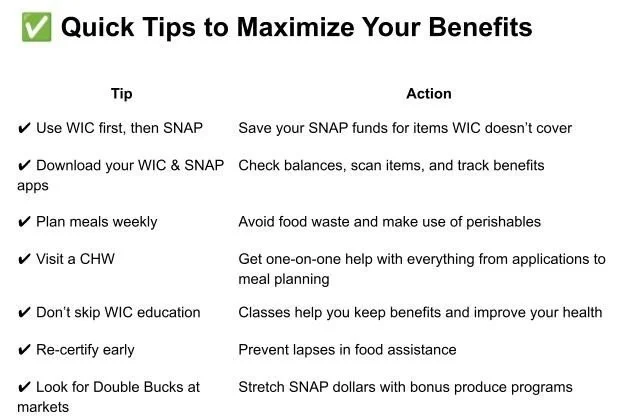Your Custom Text Here
WIC & SNAP: How to Maximize Your Benefits
Navigating government assistance programs like WIC (Women, Infants, and Children) and SNAP (Supplemental Nutrition Assistance Program) can feel overwhelming, especially when you're balancing family, work, and health. But with the right tools, support, and knowledge, you can stretch these benefits further than you might expect—and even discover additional help along the way.
This guide will walk you through how to make the most of WIC and SNAP, including how a Community Health Worker (CHW)—especially one trained through the Community Health Access Project (CHAP)—can help you every step of the way.
1. Know Exactly What You’re Eligible For
WIC and SNAP each have specific eligibility rules, but you may be entitled to more support than you think.
WIC Benefits May Include:
Infant formula and baby food
Milk, eggs, cheese, yogurt
Whole grains and legumes
Fruits and vegetables (monthly cash value benefit)
Breastfeeding support and nutrition education
SNAP Benefits May Include:
Monthly funds for most grocery items (excluding alcohol, vitamins, and prepared hot food)
Use of an EBT card at grocery stores, farmers markets, and some online retailers
📌 Tip: Report all allowable expenses (e.g., rent, utilities, childcare, medical costs for seniors/disabled) to increase your SNAP benefit.
2. Use WIC and SNAP Together Strategically
These two programs work best when used in tandem:
Use WIC for covered staples like milk, eggs, and fruits/vegetables.
Use SNAP to fill in the rest of your grocery needs—meat, pantry items, and hygiene products not covered by WIC.
By planning ahead, you can avoid using SNAP for things WIC already provides—freeing up funds for other food needs.
3. Plan Meals Around Your Benefits
To avoid waste and maximize usage:
Review your WIC food package early in the month.
Build weekly meal plans using WIC items first.
Use SNAP for missing ingredients or bulk foods.
Use leftovers creatively—turn roast chicken (SNAP) into soup with WIC-approved veggies and rice.
🍲 Recipe Idea: Make oatmeal (WIC) with sliced bananas and cinnamon (SNAP), or a veggie stir fry with brown rice (WIC) and frozen mixed veggies (SNAP).
4. Shop Smart and Stretch Every Dollar
Download your state’s WIC app to scan barcodes and confirm item eligibility.
Use coupons and BOGO deals with SNAP where allowed.
Shop at farmers markets that accept EBT—many offer “Double Up Food Bucks” to increase your produce buying power.
Buy in bulk when possible—especially rice, beans, frozen vegetables, and pasta.
🛒 Pro Tip: Many grocery stores now label WIC-approved items on the shelf. If you’re unsure, ask a store associate for help.
5. Take Advantage of Nutrition Education
WIC includes free classes that teach:
Infant feeding and breastfeeding tips
Budget meal planning and cooking
Nutritional guidelines for all ages
Many states now offer online WIC education, making it even easier to complete your sessions at home and maintain eligibility.
6. Breastfeeding? Get More Support and Benefits
WIC strongly supports breastfeeding families with:
Larger food packages for breastfeeding mothers
Access to manual or electric breast pumps
Lactation consultants and peer counselors
Special breastfeeding-friendly classes and resources
👶 Tip: Even partial breastfeeding often qualifies you for more food support than formula feeding alone.
7. Use Community Resources
Both WIC and SNAP programs connect you to other services:
Free school meals for children
Discounted internet through the Affordable Connectivity Program
Local food pantries and diaper banks
Free or low-cost clinics for immunizations and checkups
Ask your WIC or SNAP caseworker for referrals—they often know about local programs you may not be aware of.
8. Monitor Your Balances
SNAP balances roll over month-to-month but expire after 12 months of inactivity.
WIC benefits typically expire monthly—if you don’t use them, you lose them.
Check balances regularly using your receipt, state app, or EBT portal. This helps with planning and avoids surprises at checkout.
9. Re-Certify On Time
WIC and SNAP require periodic recertification. Stay organized:
Keep a folder with pay stubs, ID, proof of address, and utility bills.
Mark recertification dates on your calendar.
Respond promptly to mail or phone calls from your local office.
📌 Tip: Missing a deadline can pause or cancel your benefits, even if you still qualify.
10. Connect With Other Parents and Caregivers
You’re not alone in this. Many parents, guardians, and caregivers use WIC and SNAP to support their families. Consider:
Joining Facebook groups for WIC/SNAP users in your state
Visiting subreddits like r/povertyfinance
Attending WIC parenting groups or peer support meetings
Sharing experiences helps reduce stigma and opens the door to new tips and community events.
11. Get Help from a Community Health Worker (CHW)
If all of this still feels like too much, you don’t have to do it alone.
Community Health Workers (CHWs), especially those trained through the Community Health Access Project (CHAP), are trusted professionals who help families like yours access and navigate support systems, including WIC and SNAP.
What a CHW Can Do for You:
Help you apply or recertify for WIC or SNAP
Assist with gathering documentation and understanding eligibility
Teach you how to use your WIC/SNAP apps and balance tools
Connect you to local resources (food pantries, housing, childcare, etc.)
Ensure you're getting your maximum allowable benefits
Build a plan with you—not for you—and follow up to make sure it works
About the CHAP Model
The Community Health Access Project (CHAP) uses a structured, outcomes-focused model called Pathways. CHWs trained through this model focus on measurable results in areas like food access, housing, and health care. They don't just make referrals—they make sure you get the help you need and follow through successfully.
Learn more at: www.chap-ohio.org
Final Thoughts
WIC and SNAP aren’t just programs—they’re lifelines. By understanding your options, planning strategically, and leaning on your community (including CHWs!), you can ensure your family has consistent, nutritious food without extra stress.
You deserve support. You deserve resources. And with the right tools—and people—you can thrive.

